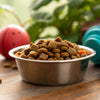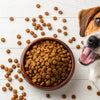What's Better for Dogs: Wet Food or Dry Food?
- Houndsy
Table of Contents
- Introduction
- Understanding Dog Food Types
- Nutritional Comparison: Wet vs. Dry Food
- Benefits of Wet Dog Food
- Benefits of Dry Dog Food
- Special Considerations
- Conclusion
Introduction
Did you know that the choice of dog food can significantly impact your pet's health and happiness? With countless options available, many dog owners find themselves asking, "What's better for dogs, wet food or dry food?" This question is not just about preference; it touches on nutrition, hydration, dental health, and overall well-being.
As responsible pet parents, we want nothing but the best for our furry companions. In this blog post, we will explore the differences between wet and dry dog food, weighing their respective benefits and drawbacks. By the end, you will have a clearer understanding of which might be best for your dog based on their specific needs and preferences. So, let’s dive into the details and help you make an informed decision that elevates your dog's feeding experience!
Understanding Dog Food Types
What is Dry Dog Food?
Dry dog food, often referred to as kibble, is characterized by its low moisture content—typically between 5% to 10%. This type of food is produced through a process that involves cooking, extruding, and then drying the ingredients to create the familiar crunchy texture. Dry kibble is popular among pet owners due to its convenience and long shelf life, making it easy to store and serve.
Nutritional Profile of Dry Dog Food
Dry dog food is generally formulated to be nutritionally complete, providing a balanced mix of proteins, fats, carbohydrates, vitamins, and minerals. The ingredients often include meat, grains, and vegetables. One of the significant advantages of dry food is its higher carbohydrate content, which helps provide energy and aids in digestion. However, the nutritional value can vary greatly depending on the brand and formulation, so it’s essential to read labels carefully.
What is Wet Dog Food?
Wet dog food, commonly found in cans or pouches, contains significantly more moisture—usually between 75% to 85%. This high moisture content is one of the key factors that can make wet food appealing to dogs, especially those who may struggle with hydration or have specific health issues.
Nutritional Profile of Wet Dog Food
Like dry food, wet dog food is designed to be nutritionally complete. It typically has a higher protein content compared to dry food, making it an excellent choice for dogs that require more energy. Wet food often includes meat, broth, and a variety of nutrients, but it may also contain fillers and preservatives, so it's crucial to choose high-quality brands.
Nutritional Comparison: Wet vs. Dry Food
Moisture Content
The most obvious difference between wet and dry food is moisture content. While dogs naturally drink water, wet food can help contribute to their hydration needs, especially for dogs that may not drink enough. This is particularly beneficial for:
- Dogs with urinary tract issues: Increased moisture can help flush out the urinary system.
- Older dogs or those with dental issues: Wet food is easier to chew and swallow.
Protein and Fat Content
On a dry matter basis, both wet and dry foods can provide similar protein levels, but wet food often has a higher fat content. This can be advantageous for active dogs needing extra energy. However, for dogs that are overweight or have specific dietary restrictions, a high-fat diet may not be ideal.
Carbohydrates
Dry dog food generally contains more carbohydrates than wet food. Carbs are essential for energy, especially for active dogs. However, some low-carb options are available in dry food and may be suitable for dogs on weight management diets.
Dental Health
One of the significant benefits of dry dog food is its potential to promote dental health. The crunchy texture helps reduce plaque buildup, contributing to better oral hygiene. Conversely, wet food does not provide the same mechanical cleaning effect, which may lead to dental issues over time.
Benefits of Wet Dog Food
- Hydration: The high moisture content can be beneficial for dogs that do not drink enough water.
- Palatability: Wet food often has a stronger aroma and flavor, which can entice picky eaters.
- Easier to Chew: Dogs with dental problems may find wet food more manageable.
- Increased Satiety: The moisture can help dogs feel fuller without additional calories, assisting with weight management.
Benefits of Dry Dog Food
- Convenience: Dry food is easy to measure, store, and serve. It has a longer shelf life and does not spoil as quickly as wet food.
- Dental Care: The crunchy texture helps scrape away plaque and can support dental health.
- Cost-Effective: Often, dry food is more affordable in the long run than wet food, especially for larger dogs.
- Food Enrichment: Dry kibble can be used in interactive feeders and puzzles, providing mental stimulation.
Special Considerations
Age and Health
When deciding between wet and dry food, consider your dog's age, health condition, and specific dietary needs. Puppies may require higher protein and fat content, while senior dogs might benefit from softer, more digestible food. Always consult with your veterinarian to determine the best diet for your dog's unique health requirements.
Mixing Wet and Dry Food
Many pet owners opt for a combination of wet and dry food to provide their dogs with the benefits of both. Mixing can enhance palatability, offer variety, and ensure adequate hydration. However, it’s essential to adjust portion sizes to avoid overfeeding and maintain a balanced diet.
Transitioning Between Food Types
If you decide to switch your dog’s food type, do so gradually over a week to ten days. This helps prevent digestive upset. Start by mixing small amounts of the new food with the current food, gradually increasing the new food while decreasing the old.
Conclusion
The question of whether wet food or dry food is better for dogs ultimately depends on individual needs and preferences. While both types can offer balanced nutrition, they come with distinct advantages and disadvantages. Wet food can aid in hydration and palatability, while dry food promotes dental health and convenience.
As dedicated pet parents, our goal is to provide our furry friends with the best possible nutrition tailored to their specific requirements. By understanding the differences between wet and dry dog food, we can make informed choices that not only nourish our dogs but also enhance their overall quality of life.
Call to Action
If you're looking to elevate your dog feeding experience, we invite you to explore our innovative Houndsy Kibble Dispenser. Designed for convenience and style, it ensures perfect portion control and complements your modern home decor while enhancing your dog's mealtime ritual.
FAQ
Is it okay to mix wet and dry dog food?
Yes! Mixing wet and dry dog food can provide a balanced approach that combines the benefits of both types of food. It can enhance palatability and offer better hydration.
Can wet food cause dental problems in dogs?
Wet food does not provide the same dental benefits as dry food. While it can be part of a balanced diet, regular dental care, such as brushing, is essential to maintain your dog’s oral health.
How do I know what type of food is best for my dog?
Consult with your veterinarian to determine the best food type based on your dog’s age, health status, and dietary needs. They can help you choose a diet that meets all nutritional requirements.
Should I always feed my dog the same type of food?
It’s not necessary to stick to one type of food. Dogs can thrive on a varied diet that includes both wet and dry food, as long as it meets their nutritional needs.
How can I transition my dog to a new food?
Gradually introduce the new food over a week to ten days, mixing it with the current food to prevent digestive upset. Monitor your dog’s response during the transition period.












